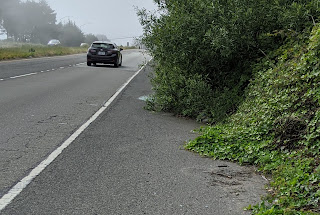Riding at night
 |
| Sunset on Mt. Hollywood Dr in Griffith Park |
Riding in the dark does not have to be a dangerous and scary experience! With some planning and proper equipment, riding at night can be just as pleasant as a daytime cruise. And you can easily extend your available riding time by starting your morning ride before the sun is up, or wrapping your afternoon ride well after sunset.
I'll share my approach to night rides by looking at 3 topics:
- Gear
- Route planning
- Safety tips
Gear
The spectrum of what you can pay for these two items is huge, from a few dollars for a cheap single blinky LED to more than a thousand of dollars for the fanciest headlight sets. I have tried a fair amount of different products over the years, and I am really happy with my current setup.
On the front I have a NiteRider Lumina 650 Wireless / USB Rechargable Headlight
 |
| NightRider 650 demo on a fairly dark street |
 |
| Danger Zone Tail Light |
Depending on your needs, you can add extra blinking lights on your chainstays that project more light to the sides. This is good if you have a lot of dark intersections or people coming out of driveways. If you are traveling on curvy roads, an extra headlamp mounted on your helmet is a good way to project light where you want it.
Route Planning
The route you take in the dark might very well differ from your daytime preference. If a road has a lot of traffic and a narrow shoulder, consider a different way at night. I also avoid roads with lots of potholes and seams when in the dark, because even with the best lights it is never the same as riding during the day.
In general a road with street lights is preferable to a dark by-way when traveling in the dark. The extra lighting allows you to see obstacles, and also allows motorists to see you.
Secluded bike paths can always be dangerous at night depending on the safety of the area (some LA paths go through rough neighborhoods), amount of lighting on the path, and even wildlife. Critter large and small can make a path dangerous at night. For example, I now avoid the Ballona creek path after almost crashing multiple times as bunnies darted right in front of my wheel during a night ride.
Safety Tips
- Always use your lights. If you have a lots of car to deal with, consider multiple flashing lights in addition to just the one tail light. Riding at night without lights is illegal in many places, don't give the police a reason to pull you over.
- Keep batteries charged and ready for when you need them. Carry an extra battery for your tail light if you think there's any chance that the battery is running low.
- Avoid dark clothing and consider reflective material to catch the attention of others
- Be predictable and always assume that cars can't see you
- Bring appropriate tools in case of a breakdown. A flat kit should be the bare minimum. In the dark you are far less likely to come across another cyclist able to help, so be prepared to take care of yourself.
- For long rides, consider bringing an extra light. Whenever I go out on a long night ride, I throw my camping headlamp (a Petzl Tikka Plus 2
) into my jersey pocket. If my headlight goes out I can wrap it around my stem to get some light in front. If my tail light goes out I have put the headband strap around my torso and put the light in blinky mode to give coverage from behind. It's not glamorous but it works in a pinch.



Thanks for your post! I've seen some people ride with lights on their wheels or helmets - thoughts on those? They're visible from miles out - however, I worry that they'll add too much weight
ReplyDeleteI've used helmet mounts and they work well (especially if on a twisty trail), but the weight on my head never feels quite right. The wheel lights are great for visibility but I've never tried them out. I worry most about getting hit by a distracted driver coming up from behind me, whereas the wheels lights are more going to help with cars coming from a 90 degree angle.
Delete